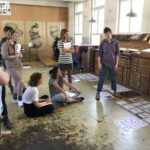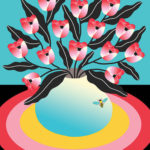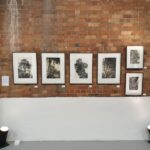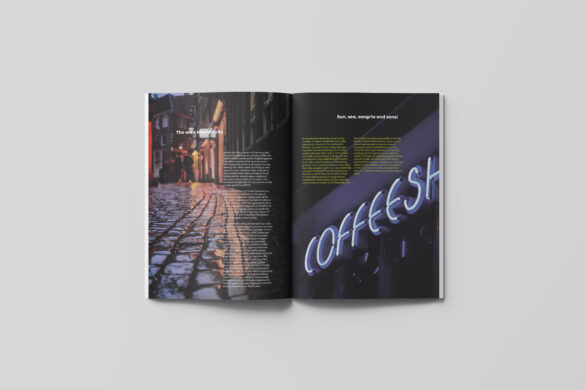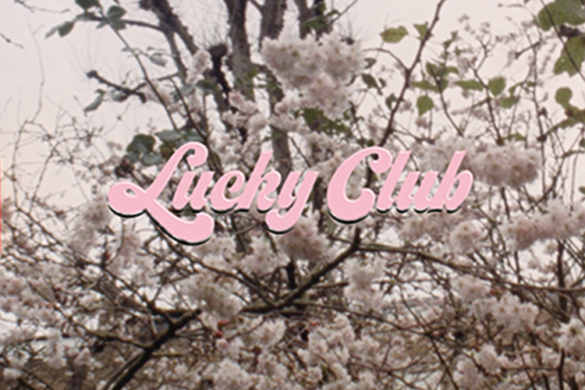Photographer Thom Atkinson’s work is an original take on documentarian tradition: there’s a distinctive calmness to his observations, which focus on people, places and objects. He describes his images as having “a natural and honest quality, and a care for the craft of picture making.”
Alongside working with clients including Volkswagen, Sainsbury’s, Missing People and Cancer Research and taking on editorial commissions for the likes of FT Weekend and Guardian Weekend Magazine, Atkinson has also published books through publishing imprint, Hwæt Books, a collaboration with his sister, Beth Atkinson. In 2015 it put out his debut photobook, Missing Buildings, which brought together an extensive body of work documenting the physical and imaginative landscapes of the London Blitz, and in doing so, united the photographers ongoing interests around Britain, conflict and mythology.

 His latest zine, Number 9 1:76, is a collaboration with design studio C-LL-CT-V-LY. Part of a series of zines published by C-LL-CT-V-LY’s publishing imprint, C-Visuals, the zine is titled Airfix Ruins and documents showroom models of war damaged buildings, loaned by Airfix. The models are based on real buildings damaged and destroyed in real wars. The design is simple, making the photos dominate each page; with simple text set in modernist sans serif Grosa by Feliciano Type.
His latest zine, Number 9 1:76, is a collaboration with design studio C-LL-CT-V-LY. Part of a series of zines published by C-LL-CT-V-LY’s publishing imprint, C-Visuals, the zine is titled Airfix Ruins and documents showroom models of war damaged buildings, loaned by Airfix. The models are based on real buildings damaged and destroyed in real wars. The design is simple, making the photos dominate each page; with simple text set in modernist sans serif Grosa by Feliciano Type.
 The work is a spinoff of sorts from the Missing Buildings book. “My work is about Britain’s relationship with war and the mythology that surrounds it,” says Atkinson. “When I made Airfix Ruins, I was looking at the idea that a society’s myths are like a group dream—stories created communally, to understand, and come to terms with, the past.
The work is a spinoff of sorts from the Missing Buildings book. “My work is about Britain’s relationship with war and the mythology that surrounds it,” says Atkinson. “When I made Airfix Ruins, I was looking at the idea that a society’s myths are like a group dream—stories created communally, to understand, and come to terms with, the past.

 “I made Airfix models as a child and I think scale modelling could be seen as an act of remembrance, and a part of that wider process of mythologising. I like to think of these buildings as sculptures or devotions to that mythology, made by a company invested in that myth, and painted by artists who are carried away by it.”
“I made Airfix models as a child and I think scale modelling could be seen as an act of remembrance, and a part of that wider process of mythologising. I like to think of these buildings as sculptures or devotions to that mythology, made by a company invested in that myth, and painted by artists who are carried away by it.”

 C-LL-CT-V-LY has created design work for clients like The Financial Times and VICE News. Founded in 2015 by creative director Mark Leeds and publisher Duncan Johnson, the limited-edition zines it puts out use “unpublished, reordered, remade, refound or newly created artworks” as “quick-fire collaborations” between the studio and a range of creatives. “We hope they provide an informal and personal insight into the artists and their work,” says C-LL-CT-V-LY, which goes on to describe them as a lovingly-assembled, “easily consumed visual hit—a kind of physical blog…”
C-LL-CT-V-LY has created design work for clients like The Financial Times and VICE News. Founded in 2015 by creative director Mark Leeds and publisher Duncan Johnson, the limited-edition zines it puts out use “unpublished, reordered, remade, refound or newly created artworks” as “quick-fire collaborations” between the studio and a range of creatives. “We hope they provide an informal and personal insight into the artists and their work,” says C-LL-CT-V-LY, which goes on to describe them as a lovingly-assembled, “easily consumed visual hit—a kind of physical blog…”
 The project started out as part of work for an existing client, to explore ways of reaching a targeted diene. “It gave us the foundation for a low volume, high quality and postable publication,” says the studio. “We’ve always enjoyed seeing creatives’ personal projects and their work in progress. This is a chance to show them—and keep them—physically. We encourage diversity and hope to invite a wider range of creative talent.”
The project started out as part of work for an existing client, to explore ways of reaching a targeted diene. “It gave us the foundation for a low volume, high quality and postable publication,” says the studio. “We’ve always enjoyed seeing creatives’ personal projects and their work in progress. This is a chance to show them—and keep them—physically. We encourage diversity and hope to invite a wider range of creative talent.”
You might like...
- Autobahn - November 26, 2021
- Alphabetical - November 12, 2021
- SOFA Universe - November 8, 2021












